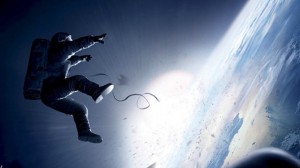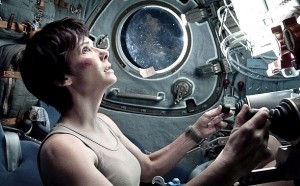Gravity (3D)
directed by Alfonso Cuaron
When you go to the movies, you normally expect films to conform to genre and function as a pleasant two-hour escape from the real world. But every so often a film will take you by surprise.
Billed as a sci-fi fantasy, Gravity is far from what you might expect. There are no aliens, futuristic technology or inter-planetary battles. Rather, it’s is a survival story set in space.
 Gravity begins with a close to silent, expansive view of Earth from above which is eventually interrupted by the sight of a distant space shuttle. Soon we’re introduced to three of its crew members who are on a mission to repair the Hubble telescope. They float like embryos attached to the umbilical cords of their spacesuits in zero gravity outside the telescope.
Gravity begins with a close to silent, expansive view of Earth from above which is eventually interrupted by the sight of a distant space shuttle. Soon we’re introduced to three of its crew members who are on a mission to repair the Hubble telescope. They float like embryos attached to the umbilical cords of their spacesuits in zero gravity outside the telescope.
But it’s not long before the serenity of the scene is disturbed. The group is told a nearby Russian satellite has self-destructed and debris is hurtling towards them travelling faster than a high-speed bullet. Matt Kowalski (George Clooney) urges medical engineer Dr Ryan Stone (Sandra Bullock) to finish her repairs before the debris hits. It’s too late, and their colleague is killed mid-air. The rest of the movie follows the story of Matt and Dr Stone’s attempts to find another space shuttle to return home in, while faced with limited oxygen and debris on the move. It is Dr Stone whose life we follow to the end of the film.
The strengths of this film are visual. A stunning portrayal of the precarious nature of space travel, it’s a movie which should be seen in 3D on the biggest screen possible. As you watch Dr Stone tumbling around in space, it’s hard not to find your stomach churning along with hers, your jaw dropping in awe of another sunrise making its way around the globe or your hands in front of your face as debris hurtles towards you.
Cinematographer Emmanuel Lubezki (Tree of Life) and Mexican director Alfonso Cuaron (Children of Men) have achieved something visually remarkable here, although at times the imagery of birth and re-birth is a little heavy-handed. The special effects alone are reason enough to go see it.
 Unfortunately, character development in Gravity is minimal, and you find yourself caring for characters you know almost nothing about. As it is, the film is preoccupied with survival, but it’s in Dr Stone’s brief moments of reflection where deeper themes are explored. As she is faced with her own mortality, the film reaches its most poignant point. She says out loud to a stranger down the line, “No one will mourn for me. Will you mourn for me?” Pondering the afterlife, and her future, she says, “I don’t know how to pray. No one taught me.”
Unfortunately, character development in Gravity is minimal, and you find yourself caring for characters you know almost nothing about. As it is, the film is preoccupied with survival, but it’s in Dr Stone’s brief moments of reflection where deeper themes are explored. As she is faced with her own mortality, the film reaches its most poignant point. She says out loud to a stranger down the line, “No one will mourn for me. Will you mourn for me?” Pondering the afterlife, and her future, she says, “I don’t know how to pray. No one taught me.”
Perhaps given the power of the visuals, it’s a film which would’ve benefited from a longer running time, so that characters could be fully developed, and themes of mortality, loneliness and the self could be explored to more depth.
Viewed in 3D, Gravity is realistic to the point of being stressful. It gives viewers a palpable experience they are unlikely to have elsewhere. In so doing, the movie forces the viewer to identify strongly with Bullock’s character, and to confront their own death in a powerful way, as well as their motivation for living–it raises questions which we often don’t have time to ask ourselves, and for that reason, as well as being a unique cinematic experience, it is worth watching.
Email This Story
Why not send this to a friend?

